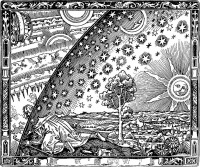Astronomical naming conventions
From The Art and Popular Culture Encyclopedia

Illustration: Flammarion engraving, a wood engraving by an unknown artist, so named because its first documented appearance is in Camille Flammarion's 1888 book L'atmosphère: météorologie populaire ("The Atmosphere: Popular Meteorology").
|
Related e |
|
Featured: |
The International Astronomical Union (IAU) is the body officially recognized by astronomers and other scientists worldwide as the de facto naming authority for astronomical bodies. In response to the need for unambiguous names for astronomical objects, it has created a number of systematic naming systems for bodies of various sorts.
Names of planets
The brightest planets in the sky have been named from ancient times. The scientific names are taken from the names given by the Romans: Mercury, Venus, Mars, Jupiter, and Saturn. Our own planet is usually named Earth, or the equivalent in the language being spoken (for instance, two astronomers speaking French would call it la Terre). However, it is only recently in human history that it has been thought of as a planet. Earth, when viewed as a planet, is sometimes also called by its Latin name Terra.
At least two more bodies were discovered later, and called planets:
- Uranus, discovered by William Herschel in 1781
- Neptune, discovered by Johann Gottfried Galle in 1846 (based on prediction by Urbain Le Verrier)
These were given names from Greek or Roman myth, to match the ancient planet names—but only after some controversy. For example, Sir William Herschel discovered Uranus in 1781, and originally called it Georgium Sidus (George's Star) in honour of King George III of the United Kingdom. French astronomers began calling it Herschel before German Johann Bode proposed the name Uranus, after the Greek and Roman god. The name "Uranus" did not come into common usage until around 1850.
Starting in 1801, asteroids were discovered between Mars and Jupiter. The first few (Ceres, Pallas, Juno, Vesta) were initially considered planets. As more and more were discovered, they were soon stripped of their planetary status. On the other hand, Pluto was considered to be a planet at the time of its discovery in 1930, as it was found beyond Neptune. Following this pattern, several hypothetical bodies were given names: Vulcan for a planet within the orbit of Mercury; Phaeton for a planet between Mars and Jupiter that was believed to be the precursor of the asteroids; Themis for a moon of Saturn; and Persephone, and several other names, for a trans-Plutonian planet.)
Derived from Classical mythology, these names are only considered standard in Western discussion of the planets. Astronomers in societies that have other traditional names for the planets may use those names in scientific discourse. The IAU does not disapprove of astronomers discussing Jupiter in Arabic using the term Template:Lang Al-Mushtarīy or astronomers speaking in Mandarin Chinese discussing Neptune referring to the planet as Template:Lang Hǎiwángxīng.
Some sixty years after the discovery of Pluto, a large number of large trans-Neptunian objects began to be discovered. Under the criteria of classifying these Kuiper belt objects (KBOs), it became dubious whether Pluto would have been considered a planet had it been discovered in the 1990s. Its mass is now known to be much smaller than once thought and, with the discovery of Eris, it is simply one of the two largest known trans-Neptunian objects. In 2006, Pluto was therefore reclassified into a different class of astronomical bodies known as dwarf planets, along with Eris and others.
See also
- Planetary nomenclature
- List of astronomical objects named after people
- List of basic astronomy topics
- List of brightest stars
- List of minor planets (includes asteroids)
- Naming of moons
- Provisional designation in astronomy

